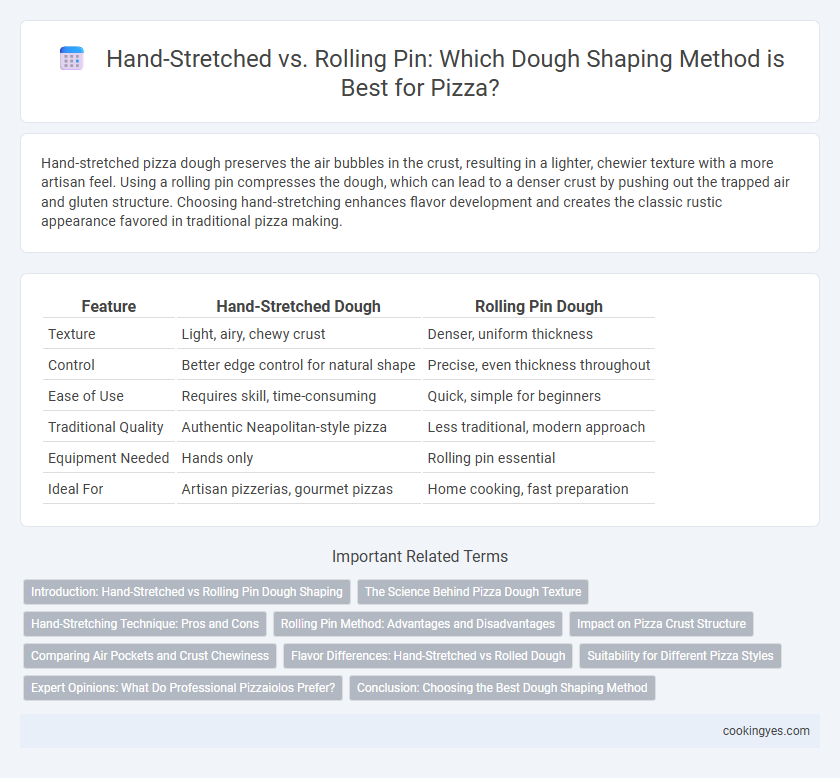Hand-stretched pizza dough preserves the air bubbles in the crust, resulting in a lighter, chewier texture with a more artisan feel. Using a rolling pin compresses the dough, which can lead to a denser crust by pushing out the trapped air and gluten structure. Choosing hand-stretching enhances flavor development and creates the classic rustic appearance favored in traditional pizza making.
Table of Comparison
| Feature | Hand-Stretched Dough | Rolling Pin Dough |
|---|---|---|
| Texture | Light, airy, chewy crust | Denser, uniform thickness |
| Control | Better edge control for natural shape | Precise, even thickness throughout |
| Ease of Use | Requires skill, time-consuming | Quick, simple for beginners |
| Traditional Quality | Authentic Neapolitan-style pizza | Less traditional, modern approach |
| Equipment Needed | Hands only | Rolling pin essential |
| Ideal For | Artisan pizzerias, gourmet pizzas | Home cooking, fast preparation |
Introduction: Hand-Stretched vs Rolling Pin Dough Shaping
Hand-stretched pizza dough preserves air bubbles formed during fermentation, resulting in a light, airy crust with a tender texture. Using a rolling pin compresses the dough, often flattening these bubbles and producing a denser, chewier crust. Chefs favor hand-stretching for artisanal pizzas, while rolling pins offer consistency and speed in high-volume settings.
The Science Behind Pizza Dough Texture
Hand-stretched pizza dough preserves gluten structure by gently elongating strands, resulting in a chewier, airier crust with enhanced fermentation bubbles. Rolling pins compress dough uniformly, often flattening gluten networks and releasing trapped gases, which can lead to a denser, less elastic texture. Scientific studies show that maintaining gluten integrity through hand-stretching promotes optimal dough hydration and gas retention, crucial for the classic Neapolitan pizza crust texture.
Hand-Stretching Technique: Pros and Cons
Hand-stretching pizza dough preserves air bubbles, resulting in a lighter, airier crust with more complex texture compared to rolling pins. This technique offers better control over dough thickness, preventing overworking and maintaining gluten structure that yields a chewier bite. However, it requires more skill and time, and uneven thickness can occur if not done carefully.
Rolling Pin Method: Advantages and Disadvantages
Using a rolling pin for pizza dough shaping offers precise thickness control and a uniform surface, making it ideal for thin-crust pizzas. This method can compress the dough, potentially reducing air bubbles and resulting in a denser crust, which may impact texture negatively for those preferring a light, airy bite. While the rolling pin provides convenience and speed, it requires careful technique to avoid overworking the dough, which can lead to toughness.
Impact on Pizza Crust Structure
Hand-stretched pizza dough preserves larger air bubbles in the crust, resulting in a lighter, chewier texture with a more artisanal open crumb structure. Rolling pin usage compresses the dough, reducing air pockets and creating a denser, uniform crust that may lack the characteristic chewiness of hand-stretched pizzas. The choice between hand-stretching and rolling pin directly influences gluten development and crust aeration, impacting the final pizza's texture and mouthfeel.
Comparing Air Pockets and Crust Chewiness
Hand-stretched pizza dough preserves air pockets better, resulting in a lighter, airier crust with enhanced chewiness due to minimal gluten disruption. Using a rolling pin compresses the dough, reducing air retention and leading to a denser, less chewy crust. Artisanal pizzerias often prefer hand-stretching to achieve the ideal balance of crispness and softness in traditional Neapolitan-style pizzas.
Flavor Differences: Hand-Stretched vs Rolled Dough
Hand-stretched pizza dough develops a superior flavor profile due to the gentle stretching preserving the delicate gluten network and allowing more even fermentation, resulting in a chewier and airier crust with enhanced yeast and malt notes. Rolled dough compresses the gluten strands, often leading to a denser texture and muted flavor complexity as rolling can cause uneven fermentation and less fermentation gas retention. The distinct tactile process of hand-stretching therefore contributes significantly to richer taste and a more artisan-quality crust compared to rolling pin methods.
Suitability for Different Pizza Styles
Hand-stretched dough creates a light, airy crust ideal for Neapolitan and traditional Italian-style pizzas due to its gentle, uneven thickness. Rolling pins produce a uniform dough thickness, making them suitable for thin-crust or Sicilian-style pizzas that require a consistent base for even baking. The choice between hand-stretching and rolling influences texture and crispiness, directly affecting the final pizza style.
Expert Opinions: What Do Professional Pizzaiolos Prefer?
Professional pizzaiolos overwhelmingly prefer hand-stretching dough, citing superior texture and air retention that creates a crispier crust and tender interior. Expert opinions emphasize that hand-stretching preserves gluten structure, enhancing elasticity and flavor development compared to rolling pins, which can overly compress the dough. This traditional technique supports artisanal quality and is favored in authentic Neapolitan and wood-fired pizza preparation.
Conclusion: Choosing the Best Dough Shaping Method
Hand-stretched dough offers a traditional texture with a chewy, airy crust, preserving gas bubbles for optimal rise and flavor, while rolling pin shaping provides uniform thickness and speed, ideal for consistent pizza bases. Selecting the best method depends on desired crust texture, preparation time, and dough hydration; hand-stretching suits artisanal, high-hydration doughs, whereas rolling pins excel in efficiency and thin crust control. Both techniques impact gluten development and final bite, influencing the pizza's overall quality and customer satisfaction.
Hand-Stretched vs Rolling Pin for dough shaping Infographic

 cookingyes.com
cookingyes.com